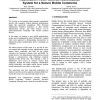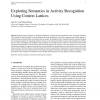16160 search results - page 155 / 3232 » How to approach humans |
COGSCI
2002
13 years 8 months ago
2002
We address the problem of predicting how people will spontaneously divide into groups a set of novel items. This is a process akin to perceptual organization. We therefore employ ...
ICRA
2009
IEEE
14 years 2 months ago
2009
IEEE
— Human hands are capable of many dexterous grasping and manipulation tasks. To understand human levels of dexterity and to achieve it with robotic hands, we constructed an anato...
IFM
2004
Springer
14 years 1 months ago
2004
Springer
Abstract. Interactive systems combine a human operator with a computer. Either may be a source of error. The veri cation processes used must ensure both the correctness of the comp...
WIS
2004
13 years 9 months ago
2004
We envision an environment where humans communicate directly with computers without additional authentication inputs like passwords, passphrases, PINs (Personal Identification Num...
JAISE
2010
13 years 3 months ago
2010
Studying human activities has significant implication in human beneficial applications such as personal healthcare. This research has been facilitated by the development of sensor ...


